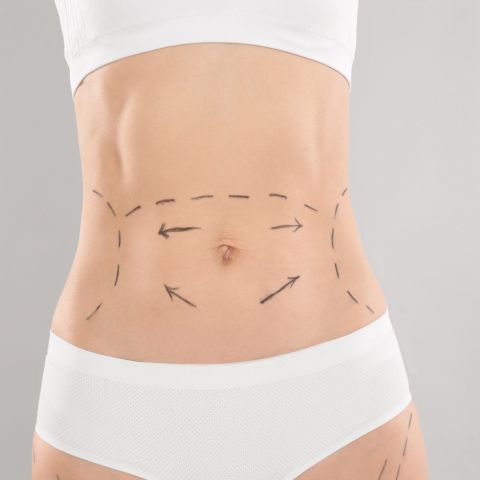

Gynecomastia is a medical condition characterized by the enlargement of the glandular tissue in the male breast, resulting in the appearance of larger and more pronounced breasts. This condition is different from pseudogynecomastia, where the enlargement is due to fat accumulation rather than glandular tissue growth. Gynecomastia can occur at any age and may be a result of hormonal changes, heredity, obesity, or the use of certain medications. It can affect one or both breasts, sometimes unevenly.
While gynecomastia isn't a serious problem, it can cause emotional distress and affect a person's self-confidence. The condition may also cause pain in the breasts. In cases where gynecomastia is caused by an underlying health issue, treating the root cause may help. However, if no such cause is found, or if the condition does not improve with conservative treatments, surgical intervention may be considered.
Gynecomastia surgery, also known as male breast reduction, is a procedure designed to reduce the size of enlarged male breasts. Like all surgical procedures, it comes with its advantages and drawbacks.
Pros of Gynecomastia Surgery:
- Improved Appearance: The primary benefit is the flatter, firmer, and more masculine contour of the chest.
- Boosted Confidence: Many men feel self-conscious about enlarged breasts. Post-surgery, there's often an increase in self-esteem and confidence.
- Permanent Results: While weight gain or certain medications can potentially cause some return of tissue, the results are largely permanent, especially if post-operative guidelines are followed.
- Reduced Discomfort: For those who experience tenderness or pain in their enlarged breasts, surgery can alleviate these symptoms.
- Minimal Scarring: Modern techniques can minimize visible scarring, making the procedure less noticeable.
Cons of Gynecomastia Surgery:
- Surgical Risks: As with any surgery, there are risks of complications such as infection, bleeding, and an adverse reaction to anesthesia.
- Scarring: Even though minimized, there's still a risk of noticeable scars, particularly if the body doesn't heal well.
- Cost: The surgery can be expensive, and not all insurance plans cover it as it's often considered an aesthetic procedure.
- Recovery Time: Some downtime is required after the surgery, usually a few days to a week off work and several weeks avoiding strenuous activities.
- Potential for Asymmetry: There's a possibility that the breasts may not look perfectly symmetrical after surgery or the nipple might be placed unevenly.
- Sensation Changes: Some men might experience a temporary or permanent change in the nipple or breast sensation.
As always, individuals should consult with a qualified plastic surgeon to discuss the potential risks and benefits specific to their situation.
Gynecomastia is the enlargement of the glandular tissue of the male breast. It's different from pseudogynecomastia, which is the accumulation of fat in the male breast area. Several factors can lead to gynecomastia.
Whether or not an individual is a good candidate for gynecomastia surgery is determined by a combination of medical, psychological, and personal factors.
Gynecomastia surgery, also known as male breast reduction surgery, is a procedure designed to reduce the size of enlarged male breasts. The specific surgical technique and timeframe can vary based on the nature and severity of the gynecomastia. Here's a general overview of the procedure and its typical duration:
1. Anesthesia: The surgery usually begins with the administration of anesthesia. Depending on the surgeon's recommendation and the extent of the surgery, local anesthesia with sedation or general anesthesia may be used.
2. Incision: The nature and location of the incision depend on the degree of gynecomastia and the surgical technique being used. Common incision patterns include a semi-circle around the areola (periareolar incision) or an inframammary incision in the crease under the breast.
3. Techniques:
- Liposuction: If gynecomastia is primarily due to excess fatty tissue, liposuction alone might be used. During liposuction, small incisions are made, and a thin hollow tube (cannula) is inserted to remove the fat using a vacuum.
- Excision: If gynecomastia is the result of excess glandular tissue or if excess skin needs to be removed, excision techniques are necessary. Here, glandular tissue, excess skin, and sometimes a part of the areola or nipple may be removed.
- Combination of Liposuction and Excision: In many cases, both techniques are used in conjunction to achieve the best results.
4. Closure: Once the desired reduction has been achieved, the incisions are sutured closed. Drains might be placed to remove any accumulating fluid, and the chest may be wrapped in bandages or a compression garment.
5. Duration: The timeframe for gynecomastia surgery typically ranges from 1 to 3 hours, depending on the extent of the procedure and the techniques employed.
6. Recovery: While the procedure itself lasts a few hours, recovery can vary. Most patients can return to non-strenuous work within a week, but full recovery and return to all activities, including exercise, might take several weeks.
It's crucial to consult with a board-certified plastic surgeon to get an accurate understanding of the surgical options suitable for individual cases and the expected timeframe for both the procedure and recovery.
After undergoing gynecomastia surgery, patients can anticipate a period of recovery where they'll experience some changes, sensations, and limitations. Here's a breakdown of what one can typically expect during this time:
- Immediate Post-surgery: You'll likely be placed in a recovery room for monitoring as the anesthesia wears off. Depending on the specifics of your surgery, you may be released the same day or require an overnight stay in the hospital.
- Pain and Discomfort: It's common to experience some pain, swelling, and discomfort in the treated area. Your surgeon will typically prescribe pain medications to alleviate these symptoms.
- Compression Garment: You may need to wear a compression garment or elastic bandage around the chest area to help reduce swelling and support the new chest contour during the initial recovery phase.
- Bruising: Some bruising is expected but should subside over a few weeks.
- Drains: If drains are placed during the surgery, they help prevent fluid buildup. Your surgeon will provide instructions on drain care and when to return to have them removed.
- Limited Physical Activity: You'll be advised to avoid strenuous activities, especially those that might strain the chest muscles, for several weeks. However, gentle movements and short walks can help with circulation and recovery.
- Follow-up Appointments: You'll have scheduled follow-up appointments with your surgeon to monitor the healing process, remove stitches and drains, and address any concerns.
- Scar Care: While incisions are usually made in inconspicuous locations to minimize visible scarring, some scarring is inevitable. Following your surgeon's post-operative care instructions, including how to care for the incisions, can help improve the appearance of scars over time.
- Sensation: Temporary numbness or changes in nipple sensitivity are possible but typically improve over time.
- Final Results: While some results are visible immediately after the swelling subsides, the final shape and appearance of the chest will continue to refine over several months.
- Emotional Adjustment: Beyond physical recovery, it's not uncommon for patients to go through an emotional adjustment period. Achieving a flatter, firmer chest contour can boost self-confidence, but it's essential to have realistic expectations and give oneself time to adapt to the new body image.
Remember, individual experiences can vary, and it's crucial to strictly follow the post-operative care instructions provided by your surgeon to ensure optimal recovery and results.
Taking care of the surgical site after gynecomastia surgery is crucial for optimal healing, minimizing complications, and achieving the best results. Here are general guidelines for post-operative care:
- Follow Surgeon's Instructions: First and foremost, always adhere to the specific instructions provided by your surgeon, as they are tailored to your individual procedure and needs.
- Compression Garment: You'll likely be advised to wear a compression garment or elastic bandage around the chest for a specified period. This helps reduce swelling, provides support to the healing tissues, and assists in achieving a smooth contour.
- Keep the Incisions Clean and Dry: Gently clean the surgical area daily using a mild soap and water, and then pat dry. Avoid scrubbing the incisions.
- Monitor for Signs of Infection: Regularly check the incision sites for signs of infection, which can include increased redness, warmth, swelling, pus, or a foul odor. Also, monitor your temperature; a fever can be an indication of infection.
- Avoid Direct Sunlight: Exposure to direct sunlight can darken scars, making them more noticeable. Protect the surgical area from the sun for at least a year post-surgery. If you do go outside, wear protective clothing or apply a high-SPF sunscreen to the scarred area.
- Limit Physical Activity: Refrain from strenuous activities, heavy lifting, and exercises that strain the chest muscles for several weeks or as advised by your surgeon. However, short walks and gentle movements can promote circulation and aid recovery.
- Manage Pain and Swelling: Take prescribed pain medications as directed by your surgeon. Over-the-counter pain relievers can also be considered, but always consult with your surgeon before taking any medications. Avoid certain anti-inflammatory drugs as they can increase bleeding.
- Stay Hydrated and Maintain a Balanced Diet: Proper nutrition and hydration can accelerate the healing process. Consider a diet rich in proteins, vitamins, and minerals, and avoid excessive salt, which can exacerbate swelling.
- Avoid Smoking and Alcohol: Smoking can significantly hinder the healing process by restricting blood flow to the surgical area. Alcohol can interfere with medications and increase the risk of complications.
- Attend Follow-up Appointments: Regular check-ups with your surgeon are essential to monitor healing and address any potential issues or concerns.
Remember that everyone's healing process is unique, and results will manifest over time. Patience and diligent care of the surgical site are vital for achieving the desired outcome. Always communicate with your healthcare provider about any concerns or questions you may have during your recovery.
Turkey has become a popular destination for various medical procedures, including gynecomastia surgery, due to its blend of experienced surgeons, advanced healthcare facilities, and cost-effective rates.
In Turkey, the medical tourism industry has flourished, drawing patients from all over the world. Turkish clinics often have state-of-the-art facilities, with surgeons trained both domestically and in renowned institutions overseas. The country adheres to international healthcare standards, ensuring high-quality care. Additionally, the lower cost of living and favorable exchange rates make medical treatments more affordable without compromising on the quality of care.
Western Europe: Gynecomastia surgery in countries like the UK, France, or Germany might cost anywhere between €3,000 to €6,000 or even higher, depending on the clinic, surgeon's reputation, and intricacy of the surgery.
USA: In the United States, the price can be even steeper, ranging from $4,000 to $8,000 or more, excluding additional costs like consultation fees, post-operative care, or any required medical tests.
Turkey: Conversely, in Turkey, the cost for gynecomastia surgery can be much more appealing, with prices ranging from €1,000 to €3,000, including consultation, the surgery itself, and sometimes even post-operative care. Even after factoring in travel and accommodation expenses, many find it economically advantageous to have the surgery in Turkey.
Choosing to undergo gynecomastia surgery in Turkey not only offers substantial financial savings but also allows patients to recuperate in a beautiful and culturally rich environment. Always ensure that you select a reputable clinic with experienced surgeons and check for genuine patient reviews and accreditations.
Choosing Elara Medical Tourism for your gynecomastia surgery in Turkey is about more than just the procedure. Here's why:
1. Expertise and Experience: At Elara, we collaborate with some of Turkey's most proficient and seasoned surgeons who specialize in gynecomastia surgery. These professionals have not only honed their skills domestically but have also undergone training and fellowships in globally recognized institutions.
2. Tailored Care: Every individual's body and expectations are unique. Elara understands this and ensures a personalized approach to care, from initial consultation to post-operative support.
3. Comprehensive Packages: With Elara, medical tourism is seamless. We provide comprehensive packages that include not only the surgery but also accommodation, transfers, and sometimes even leisure activities. This holistic approach means patients can focus solely on their recovery and enjoyment.
4. International Standards: Elara's partner clinics and hospitals in Turkey adhere to international healthcare standards. We ensure that the facilities are accredited by global bodies, guaranteeing you receive world-class care in a safe and hygienic environment.
5. Transparent Pricing: No hidden fees or unexpected costs. Elara believes in transparent pricing, ensuring patients are well-informed about the financial aspect of their medical journey.
6. Post-Surgery Support: Recovery doesn't end once you leave the hospital. Elara provides post-surgery support, guiding patients through the healing process and addressing any concerns they might have.
7. Cultural Experience: Turkey is a land of rich history and diverse culture. While you're here for your medical needs, Elara ensures you also get a taste of the beauty and charm of this country, making your trip not just about healthcare but also a unique experience.
By choosing Elara Medical Tourism, you're not only opting for a medical procedure but a holistic journey that prioritizes your health, comfort, and experience.




